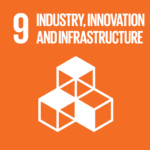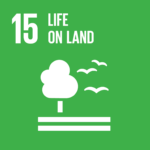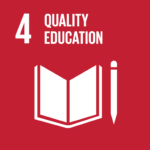Successful innovations require a strong connection with local communities, a multi-stakeholder approach and a lot of creativity. Youth can lead the way in that process – and that’s exactly what happened during the UN2023 Gamechanger Challenge. The following five youth-led innovations will take the stage during the Youth & Education event of the New York Water Week on the 20th of March, 2023. Every idea can become the next gamecahnger the water sector needs. Read more about them below.
Algeanius: nature-based solutions in water treatment processes.
Water scarcity is a great threat to human life on earth. By 2025 more than two-thirds of the world’s population will be facing water scarcity (WWF, 2022). Even though the Earth’s surface is covered with water for 71 percent, we can only use the 3% available to us. That is because most water is saline. Current methods to desalinate water, like reversed osmosis, work, but are energy intensive. These methods leave a large ecological footprint and do not help with reaching the UN SDGs.
Water scarcity is an only increasing problem to human life. Using and reusing our water in a smart and circular way, becomes therefore essential. Current water treatment processes are advanced and able to clean water,so it returns to nature, rivers, and oceans in a safe way. However, this is not completely circular. Thinking like nature, in other words: nature-based innovations, offer a different aspect of solutions. How can we create a water treatment process that is both future proof and nature inclusive? How can Nature Based Solutions contribute to water treatment processes?
- Location: The Netherlands
- Water theme: Water Quantity
- Knowledge institutions: Technical University (TU) Delft, Wageningen University and Research
Sigmuan: smart technologies in water security.
- Location: Philippines, Belgium, the Netherlands
- Water theme: Water Security
- Knowledge institutions: University of the Philippines Los Banos, Philippines; Ghent University, Belgium; Wetsus, the Netherlands.
In developing countries, like the Philippines, waterbourne diseases are one of the leading causes of death. Worldwide, nearly 1 million people die each year due to water-related diseases (United Nations Water). However, it could get worse if we do nothing. Industrialization caused the contamination of surface and groundwater with harmful pollutants. These include petroleum hydrocarbons, urban and agricultural runoffs, and pharmaceuticals. The World Health Organization reported that at least 2 billion people use contaminated water sources, which could be avoided through continuous monitoring Since for at least 3 billion people, water quality is unknown due to a lack of monitoring. There is a huge gap in water monitoring of poor and rich countries. Reasons for a lack of monitoring is associated with conventional methods.
Water samples must be collected from the field which is time consuming and hazardous, and laboratory analysis of water contaminants is costly. Although specialized sensors are used, these are expensive and difficult to maintain. To ensure water quality in the regions with most pressing water and resources challenges, we must find a more accessible solution to measure water quality, and reducing the impact of natural disasters on humans, animals, and nature.
Quality monitoring and data-gathering is essential to improve water quality and signal areas that deserve more attention. However, resources are limited in both technical, financial, and human capital terms – especially in communities that are less accessible (e.g., indigenous people, mountainous areas, SIDS). This limitation mustbe overcome to reduce the impact of water quality disasters and ensure clean, affordable water for consumption and production.
Ladakh: water conservation in mountainous areas – artificial glaciers
Without water, there is no life. With rising temperatures and melting ice caps, certain areas in the world are increasingly confronted with too much or too little water. Where mountains have always been ‘batteries of water’, they are now a significantly less reliable source of water. One of the regions where this issue is rising concerns for farmers and their communities in the northern Indian region of Ladakh.
- Location: India
- Water theme: Water Quantity
- Knowledge institutions: Himalayan Institute of Alternatives Ladakh (HIAL), India
The Trans-Himalayan region is primarily agrarian and is dependent on glacial melt as the main source of water. Due to reduction in winter precipitation, water flow is erratic during the spring sowing season, impactingagriculture. Increase in average temperatures and precipitation during summers elevates the frequency of flash floods. Since the 12th century, locals have used the annual freeze-thaw cycle to conserve water. New challenges such as climate change, water scarcity and population growth ask for a modernizing perspective of ancient practices. The local region must cope with great changes in water availability and must implement a certain flexibility in water use. Therefore, how can Mountainous areas and their communities ensure water availability?
Oceanic: Plastic collection & recycling system
Plastic pollution is a global problem. Our local communities struggle with it, our beaches are covered in it, our oceans become unlivable because of it. Whether it is an orphanage in Pretoria, South Africa, or the streets of New York – plastic pollution is everywhere. The sources are not always clear, leaving land spills and beaches overflowing with plastic litter.
- Location: South Africa
- Water theme: Water Quality
- Knowledge institutions: University of Pretoria
This leads to environmental challenges, especially for animals, as well as health risks. Efforts intended to tackle the plastic pollution problem are either focused on reducing the plastics: using less plastic in products or using recycled plastic, or efforts are focused on collecting plastics. If both these strategies are to be successful, the local community needs to be involved. Within the vision of the Circular Economy, can we combine these strategies and work towards a closed loop of plastic production, consumption, and recycling? Can we think of innovations that both benefit local communities and nature?
Pauwes: resilient cities: rainwater harvesting systems.
Growing water scarcity, climate change, rapid urbanization, and increased demand for water are a combination of challenges best described as a wicked problem. Developing countries are facing a combination of severe water challenges. Nigeria is one of them, where communities struggle with water quantity and lack the resources to fully reach the potential of the water that is in their reach.
For cities and communities to become resilient, the long-term benefits of using alternative water sources, such as rainwater, are key. Solutions such as rainwater harvesting have been used for thousands of years. How can we ensure these approaches are future proof? Think of new technologies and modernization, but also how to involve the local community, raise awareness and education. How can we save and secure (rain)water in cities?
- Location: Nigeria, Ghana
- Water theme: Water Quantity
- Knowledge inKnowledge institutions: Pan African University Institute for Water and Energy Sciences including Climate Change (PAUWES)stitutions: University of Pretoria
Adopt an idea and take these innovations to the next stage!

- Guide ambitious students towards implementation of their water-related idea. Both non-financial as financial guidance is possible and up for discussion with the students.
- Connect the students to your (local) network of public and private sector organizations that can help with the development of their idea.
- Reach out to community@wavemakersunited.com for more information.



















